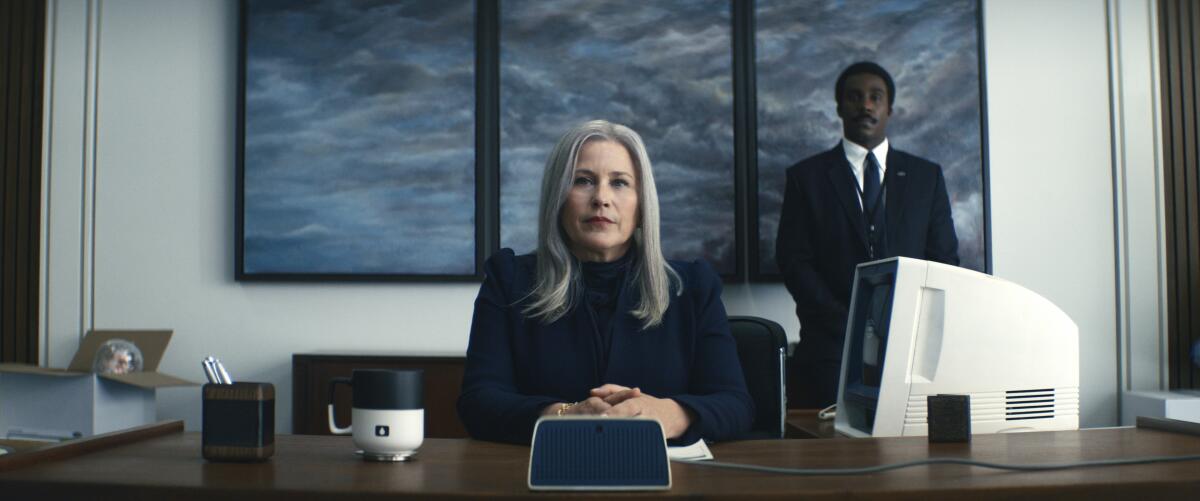How Patricia Arquette plays a villain even as she keeps tabs on humanity

When Patricia Arquette was preparing to shoot âSeverance,â she had myriad questions about the showâs internal logic and the mysteries that would only slowly be unpacked (if at all) over its first season. But none of that was her greatest concern. âMaybe for each of [the actors] in our own way,â she says, âit was more like, âYeah, this thing will work, but am I going to be the person who fâ it up? Is this tone too much? Not enough? Is what Iâm doing working, or is this insane?ââ
The 54-year-old Oscar- and Emmy-winning actress neednât have worried: She, like the rest of the ensemble, expertly executed a precise balance of dark comedy and quiet dread, visceral suspense and crushing pathos. Nominated for supporting actress in a drama, Arquette is taking a quick break from directing her first feature â an adaptation of Cheryl Della Pietraâs novel âGonzo Girlâ â to reflect on what, exactly, she got herself into when she signed up for this seductive, unsettling Apple TV+ brain-bender.
In it, she plays Harmony Cobel, an unsmiling middle manager at Lumon Industries, a sinister corporation that has invited its workforce to undergo âseverance,â a medical procedure that separates employeesâ office memories from their home lives. On the job, Cobel browbeats the timid new head of Macrodata Refinement, Mark (Adam Scott), and then out in the real world, she continues closely monitoring him, going undercover as his seemingly harmless, overly friendly next-door neighbor Mrs. Selvig.
When executive producer Ben Stiller, who directed a majority of the first seasonâs episodes, approached Arquette, he gave her only creator Dan Ericksonâs pilot âand Cobelâs hardly in it.â But she put her trust in Stiller, with whom sheâd co-starred in the 1996 indie comedy âFlirting With Disaster,â and teamed up again for the 2018 Showtime limited series âEscape at Dannemora,â which he directed.
âHe spends so much time thinking through each thing and how he wants it to feel and look,â she says of working with her friend on âSeverance.â âHeâs very clear, so that was really helpful.â She adds, laughing, âI know he knew what he was doing, even though I didnât know what he was doing.â
The director and his star learned much about perseverance and trusting each other while making the dystopian series.
Where many of her castmates were wrestling with playing roles that were, in essence, split personalities â one life at the Lumon offices, one life back home â Arquette got to dig into a villain who herself is slyly playing another character. âAs Selvig, Cobel knows what she knows about human beings and their behavior and subconscious triggers,â notes Arquette. âHer decision is to make [Selvig] a fumbling, bumbling, auntie type â someone who [Mark is] not really worried about.â
In a sense, Arquette was likewise drawing from her own observations of human nature to capture Cobelâs chilly, autocratic demeanor. Specifically, she thought of the sleek tech offices sheâs visited. âIâve done speaking engagements, and Iâve toured through those: âOh, hereâs our pinball machine room âŚâ They feel very artificial â I donât know, itâs weird.â But she also did research into âcults and armies and different structures where they give you a little, and then take away a bunch.â
The showâs suffocating paranoia was felt acutely during shooting, which took place in the early, anxious months of COVID-19. This was before vaccinations, requiring the cast to be separated from each other, and although the producers followed careful protocols, there was still risk involved. âWe had this scene where I have to scream in [co-star Sydney Cole Alexanderâs] face, and I was like, âIâm so scared to yell in this beautiful young womanâs face. What if I got her sick?â It added a whole different dimension. Never in acting have [I thought] I could really injure [my co-star] because of whatâs happening in the world. There was just so many levels of âI want to be close to somebody, and Iâm scared to be close to anybody.ââ
Arquetteâs fraught reminiscences bring to mind one of the showâs troubling themes, which is whether it would ever be worthwhile to literally cordon off your home and work selves. For actors, that question is particularly intriguing because of the emotional demands their roles impose on them.
âPretty much, I leave it there,â Arquette says of her job. âOn âThe Act,â before each scene I was like, âIâm so sorry this lady did these terrible things to her daughter â sorry, Joey [King].â I would just leave it there and go bike riding, and weâd go to dinner and laugh.â But there are exceptions. âWith âEscape at Dannemora,â there was a low-grade depression that I felt [that character] had â that was hard to get rid of,â she says. âMy movie âThe Wannabe,â which I really wasnât crazy at all about the ultimate cut, I was playing this woman that I decided was suicidal subconsciously. That was the hardest thing to ever get away from â not [that I was] feeling suicidal, but it was really intense and scary.â
As Arquette waits for Season 2 scripts, sheâs focused on âGonzo Girl,â but sheâs also worried, seeing in âSeveranceâ a metaphor for the way powerful institutions insinuate themselves in our lives â often without much resistance. A longtime activist for gender equality, she got her first job working at Planned Parenthood; just weeks after the overturning of Roe vs. Wade, Arquette wonders about the fight ahead.
âYou can get conditioned â you can lose the desire to fight,â she warns. âA friend of mine was just in Ukraine and talking about Russia and how, especially outside of Moscow or St. Petersburg, thereâs sort of an acceptance now after so many decades of this way of governance.
âI just get so frustrated with people [in our country],â she continues. âThis was my great fear in 2016: what was going to happen with the Supreme Court. I tried to make people aware: âAll the things that youâre going to want are going to get knocked down by the same Supreme Court youâre going to let in.â
âBut the amount of people that are on board with this stripping of civil rights â women being treated like their bodies [are] property of the state, even crime victims â itâs unbelievable to me. It does feel like weâre living in a bit of a nightmare now. And I am very afraid of what this says about our country and our humanity.â
More to Read
From the Oscars to the Emmys.
Get the Envelope newsletter for exclusive awards season coverage, behind-the-scenes stories from the Envelope podcast and columnist Glenn Whippâs must-read analysis.
You may occasionally receive promotional content from the Los Angeles Times.











